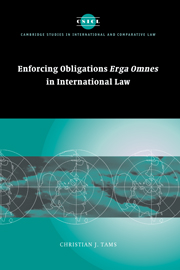Book contents
- Frontmatter
- Contents
- Foreword
- Preface
- Notes on citation
- Table of cases
- List of abbreviations
- Introduction
- Part I Background to the erga omnes concept
- Part II Legal issues raised by the erga omnes concept
- 3 Distinguishing types of erga omnes effects
- 4 Identifying obligations erga omnes
- 5 Standing to institute ICJ proceedings
- 6 Standing to take countermeasures
- 7 Erga omnes enforcement rights and competing enforcement mechanisms
- Conclusion
- Bibliography
- Index
- Cambridge Studies in International and Comparative Law
4 - Identifying obligations erga omnes
Published online by Cambridge University Press: 24 July 2009
- Frontmatter
- Contents
- Foreword
- Preface
- Notes on citation
- Table of cases
- List of abbreviations
- Introduction
- Part I Background to the erga omnes concept
- Part II Legal issues raised by the erga omnes concept
- 3 Distinguishing types of erga omnes effects
- 4 Identifying obligations erga omnes
- 5 Standing to institute ICJ proceedings
- 6 Standing to take countermeasures
- 7 Erga omnes enforcement rights and competing enforcement mechanisms
- Conclusion
- Bibliography
- Index
- Cambridge Studies in International and Comparative Law
Summary
Having distinguished different types of erga omnes effects, it is possible to discuss how the erga omnes concept affects the rules of law enforcement. The main questions arising in this regard have been summarised above. The first of these, prompted by the Court's Barcelona Traction dictum, is which obligations qualify as obligations erga omnes. This is not an issue of law enforcement proper; however, it needs to be addressed, as the relevance of the erga omnes concept depends on it. Despite decades of discussions, the question has not been solved satisfactorily. Michael Reisman expressed a widely-shared scepticism when professing that he ‘was not certain as to how various norms entered into the magic erga omnes circle.’ Two factors are chiefly responsible for this problematic state of affairs.
First, the ICJ's jurisprudence is inconclusive. Having proclaimed the concept, the Court has subsequently taken a rather cautious approach, and has said very little on how to identify the new category of obligations. To be sure, it has expressly recognised a number of narrowly defined examples of obligations erga omnes, namely the prohibitions against aggression, slavery, racial discrimination, and genocide whose erga omnes status is indeed widely accepted today. More recently, the Court has gone beyond narrowly defined examples when observing that a concept as wide as the right of peoples to self-determination or the rules of international humanitarian embodying ‘elementary considerations of humanity’ applied erga omnes.
- Type
- Chapter
- Information
- Enforcing Obligations Erga Omnes in International Law , pp. 117 - 157Publisher: Cambridge University PressPrint publication year: 2005

